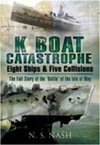Great World War II Battles in the Arctic
Evans, Mark Llewellyn
1999, Greenwood Press, Westport
ISBN 0313308926
Hardcover, 165 pages, 15 b&w photos
| Type. | General History |
| Pros. | Well-researched, good coverage of subject |
| Cons. | None to speak of |
| Rating. |  |
 This well-written overview of World War II naval warfare in the Arctic regions is both entertaining and informative.
This well-written overview of World War II naval warfare in the Arctic regions is both entertaining and informative.
The book begins by painting a picture of the arduous nature of warfare in the Arctic, which both the convoys and their predators had to endure - the cold, the foul weather, ice buildup, the slim chances of survival upon entering the frigid waters, and atmospheric conditions which complicated communications.
After providing some background on the Washington naval treaty and the gradual buildup of German naval power, the author points out that the Kriegsmarine's major handicap, lack of air support, was shared in some proportion by the Allies as well. The theory behind convoys, and the lack of attention initially devoted by the British to air and submarine threats, are also covered, in addition to a description of life on corvettes (the so-called cheap-and-nasties) and developments in anti-submarine warfare.
Specific battles covered include Germany's invasion of Norway; the actions of German surface raiders, Luftwaffe, and U-boats against various PQ and QP convoys; and an interesting chapter on weather ships and the change in strategy which led to setting weather teams ashore, and the efforts of small groups of Norwegians, Danes, Inuit, and others to locate and destroy these land-based stations.
Naturally convoy PQ-17, whose name is often used in company with words like "disaster" and "debacle", is covered in detail. PQ-18 also merits a full chapter. Further chapters focus on other convoy operations and battles; the destruction of the Scharnhorst; and the loss of the Tirpitz.
A very valuable aspect of this book is that the author presents the points of view of all parties involved in these operations, emphasizing that in this particular theater, the same fears and sufferings were shared by all, and the common enemy was the Arctic itself.
The author takes a dim view of Russia throughout the book, quoting veteran Merchant Mariners to demonstrate that the Soviets did little to aid the Allies in their efforts to transport the goods that Russia ostensibly needed, and that the Soviets harbored resentment against their allies because of the disparity in wealth between Soviet citizens and convoy personnel.
The leadership of all nations comes in for the author's criticism for their lack of coordination and cooperation between different service arms. The book finishes with an evaluation of the overall necessity and utility of the Arctic convoys. Did the supplies conveyed really save Russia from defeat? Or was it merely political expediency, the need to keep Russia in the war and on the Allies' side, that was the motivation behind these convoys?
Evans believes that Russia was never in danger of defeat; her resources were too vast, her winters too severe, her people too inured against Nazism and its racial views. He examines the question of why the Persian Gulf route (along the U.S. east coast, through the Panama Canal, down the west coast of South America, through the Madagascar Strait to the Indian Ocean, and finally through the Strait of Hormuz to the Persian Gulf) was not used instead, as it would have meant many fewer casualties, friendlier weather conditions, and fewer encounters with prowling adversaries. Although the route was much longer, more cargo would have been delivered because there would have been fewer losses along the way. Evans' answer, that Stalin insisted on speed over safety, once more emphasizes the political reasons behind the continued use of the Arctic route that those compelled to endure it came to refer to as the Suicide Run.
Review written by Tonya Allen.
Published on 18 Jun 2000.
This title is highly recommended.
Purchase information: (info) Get Great World War II Battles in the Arctic now at amazon.com ($ 75.04)
Get Great World War II Battles in the Arctic now at amazon.com ($ 75.04)
Return to our main review page.



